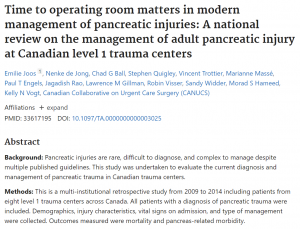
Dr. Emilie Joos, associate director at BISC, along with colleagues recently undertook a study to evaluate the current diagnosis and management of pancreatic trauma in Canadian trauma centers.
To read the full text, please visit here.
Abstract
Background: Pancreatic injuries are rare, difficult to diagnose, and complex to manage despite multiple published guidelines. This study was undertaken to evaluate the current diagnosis and management of pancreatic trauma in Canadian trauma centers.
Methods: This is a multi-institutional retrospective study from 2009 to 2014 including patients from eight level 1 trauma centers across Canada. All patients with a diagnosis of pancreatic trauma were included. Demographics, injury characteristics, vital signs on admission, and type of management were collected. Outcomes measured were mortality and pancreas-related morbidity.
Results: Two hundred seventy-nine patients were included. The median age was 29 years (interquartile range, 21-43 years), 72% were male, and 79% sustained blunt trauma. Pancreatic injury included the following grades: I, 26%; II, 28%; III, 33%; IV, 9%; and V, 4%. The overall mortality rate was 11%, and the pancreas-related complication rate was 25%. The majority (88%) of injuries were diagnosed within 24 hours of injury, primarily (80%) with a computed tomography scan. The remaining injuries were diagnosed with ultrasound (6%) and magnetic resonance cholangiopancreatography (MRCP) (2%) and at the time of laparotomy or autopsy (12%). One hundred seventy-five patients (63%) underwent an operative intervention, most commonly a distal pancreatectomy (44%); however, there was great variability in operative procedure chosen even when considering grade of injury.
Conclusion: Pancreatic injuries are associated with multiple other injuries and have significant morbidity and mortality. Their management demonstrates significant practice variation within a national trauma system.
